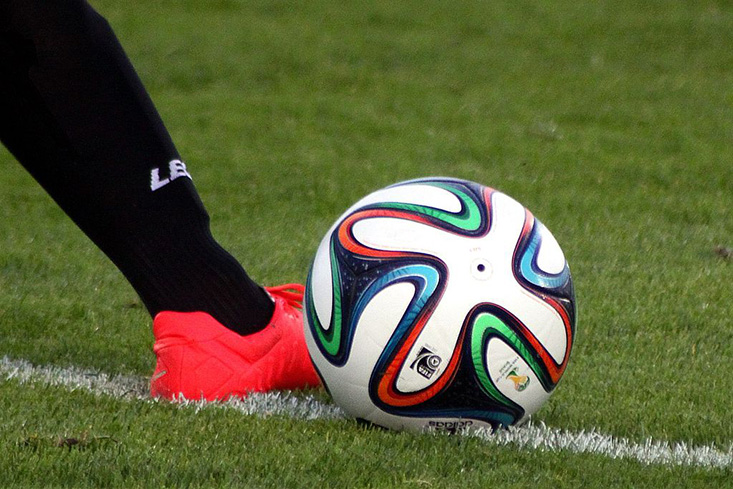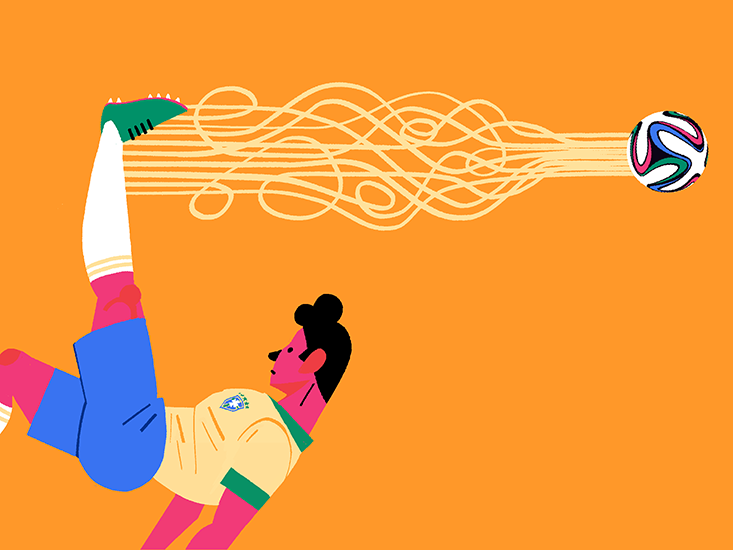You know the star players’ names of this World Cup: Brazilian forward Neymar, United States goalkeeper Tim Howard, Argentinian forward Lionel Messi. But there is one star that you may not have heard of, even though it has played in every single game this year. It’s called Brazuca, and it is a soccer ball.
When the World Cup was first played, in 1930, balls came in all sorts of designs, the most popular featuring 11 interlocking T-shaped leather panels laced together by hand. Legend says that when Italy hosted the second World Cup in 1934, Mussolini required that an Italian-made ball be used. France demanded a locally-made ball as well, when it played host in 1938. In 1970, the era of standardization started when Fédération Internationale de Football Association (FIFA) named Adidas as the official ball provider for the World Cup.
For the 2006 World Cup, Adidas introduced a new ball called Teamgeist, which created some turbulence off the field. With its 14 panels and glossy texture, Teamgeist was the smoothest ball ever—which proved to be a disaster. Shots did not fall where strikers expected them to, and goalkeepers struggled to predict flight patterns. Even David Beckham struggled to “bend it like Beckham.” While Adidas attempted to address these complaints with their 2010 ball, called Jabulani (or “rejoice” in the Bantu languages of South Africa), players still complained the ball felt “supernatural,” and had a mind of its own. The 2010 tournament ended with 147 goals, fewer than any other since the tournament was changed to the 64-game format in 1998.
NASA aerodynamics engineer Rabindra Mehta, Ph.D., has been studying the behavior of sports balls since his university days, and says there can only be one reason the play changed so drastically: It’s all about the ball. Nautilus spoke with Mehta about the aerodynamic problems swirling around the 2006 and 2010 balls, and why this year’s World Cup is on track to be the highest-scoring tournament since 1998.

What was wrong with the 2010 ball?
Every object has a boundary layer, which is basically a thin layer of air very close to the surface of the object. On a soccer ball, it’s just a millimeter or two thick. The boundary layer eventually becomes turbulent at a critical speed. So, when a ball hits that critical speed, the boundary layer gets energetic and gains momentum. The drag [behind the ball] drops, causing the ball to “knuckle”—the ball’s flight pattern suddenly takes on a mind of its own. The ball might change direction several times or it might go straight for a while and then suddenly take off in one direction. The ball knuckles the most when it hits the critical speed.
Prior to 2006, this happened around 35 miles an hour. In 2006 the ball was a lot smoother and it happened around 45 miles an hour. Then in 2010 that speed rose to 53. Most players kick the ball at 50-60 miles an hour, which is why many balls knuckled in 2010. This year, the ball is rougher and the critical speed is 38 miles an hour, so when the ball is moving at 55, its path is predictable again.
You’re saying that the 2014 ball knuckles at 38 mph but not at 55 mph. Why doesn’t knuckling get worse as the speed increases?
That might seem intuitive, but it’s not how it works. Knuckling is most pronounced at the critical speed. If you kick the ball beyond that critical speed, then the boundary layer will be in the turbulent state the entire time. If it starts out turbulent, it will never go through the transition. Drag will be low right from the start, because once the ball is past critical speed, it remains in the low-drag state. And because it never goes through the transition, it does not knuckle. This brings up another thing. When kicked at 50 mph, the 2014 ball will get to its destination faster than the 2010 ball, because the 2010 ball had more drag at 50 mph.
Why did Adidas make the 2010 ball so smooth?
Whether it happened by accident or design, I don’t know. But if FIFA came to somebody like me and said we want a ball that flies better at these speeds, I know what to do. If they came and said, “No, we want the excitement,” then we’ve been there, we were there in 2010, and the players didn’t like it.
Perhaps the understanding wasn’t quite there when they started, I’ll say, fiddling with the surface. In 2006 the balls got a lot smoother and we saw the result of that. And then in 2010 they tried to make adjustments by putting extra grooves and ridges on, presumably, so that they could lower the speed back to 35 mph. But if they were trying to reduce this critical speed, they didn’t really succeed because they made it slightly worse. So this time around we are back to square one.
This year’s ball has the fewest number of panels yet. Why?
There are only six propeller-shaped panels this year, but the lengths of the seams are up from about 200 centimeters in 2010 to 330 centimeters, and the depth went up from about 0.5 millimeters to 1.5 millimeters. There are also these small pimples on the surface, which break up the airflow, too. What does all this mean? The overall roughness of this ball is higher than that of 2010.

Does the symmetry of the panels matter?
If the panels on the ball are different shapes and sizes, there will be different amounts of roughness on different parts of the ball. So when the ball is kicked without spin, there are smooth sides of the ball and seamed sides. This means the boundary layer will behave differently on the different sides, because on some, the air is hitting the seams. This can increase knuckling.
Is the Brazuca easier to spin?
By spinning it just right, the pressure on each side of the ball will be different. The best strikers know how to do this just right—they practice it over and over, and these goals are not fluke goals. Now that the ball is rougher there is more friction, which makes it easier to put spin on the ball and control where it’s going. The increased roughness also helps to produce more side force, which makes the ball curve.
Does this explain why we have already seen 156 goals in the first 60 games this year—a 40 percent increase compared to 2010?
I think you should not discount the ball when you look at this statistic. Maybe now, they’re more comfortable taking these long kicks because they know where it’s going to go. Perhaps the biggest marker of how good the ball is, is that I have not heard a single negative word about it. When England lost to Uruguay a reporter asked me, “Well can they blame the ball?” And I said they sure can, but they shouldn’t.
Danielle Elliot is a writer based in New York. She focuses on science, sports, and the many intersections of the two. Her work has appeared online in National Geographic, The Atlantic, Grantland, and other publications and has aired on NBC, ESPN and FOX Sports.






























